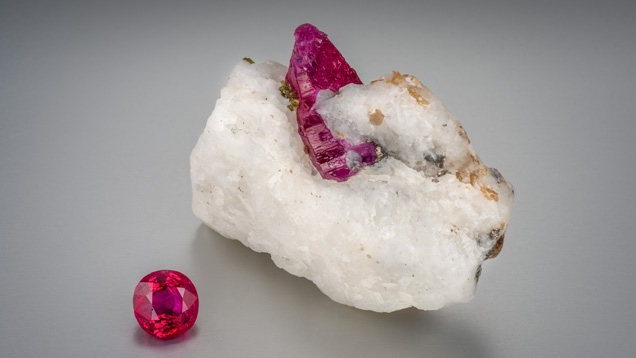The Geographic Origin Dilemma
Welcome to the Winter 2019 edition of Gems & Gemology. This issue is special in that it is devoted exclusively to one timely subject: the determination of geographic origin for specific colored stones.
Geographic origin determination is one of the most pressing issues facing the industry—a subject with many facets and complexities that should be addressed if the discussion is to be thorough.
As part of GIA’s consumer protection mission of ensuring the public trust in gems and jewelry, our purpose with this issue is to lay out what we know about determining geographic origin and how we arrive at those opinions. These articles will present every aspect of geographic origin as these authors understand it—including full transparency on the approaches and testing methods typically applied in GIA’s gemological laboratories.
We intend for this issue to promote healthy and useful discussion and debate—fueled by our collective interest in bringing more understanding and consistency to the reporting of the geographic origin of colored stones.
THE CHALLENGES THAT FACE US
Geographic origin is, today, one of the least understood subjects the industry has ever experienced. Most people, other than the experts in the gemological laboratories who perform this service, do not understand the complexities accompanying the determination process. Many, including consumers, tend to misunderstand what geographic origin reports represent. Some in the industry use this lack of understanding to market stones carrying these reports in unethical ways.
The colored stone trade wants the laboratories to be able to tell them with 100% accuracy where their colored gemstones come from, and for these determinations to be consistent between all the major laboratories. Unfortunately, science cannot provide this capability. In fact, science by itself cannot even come close to this for certain gemstones—most notably blue sapphires.
Thus, laboratories must rely on the experience of their most senior gemologists, and their familiarity with gem material from the many different deposits around the world, to arrive at these determinations. This skill takes decades to develop, and even then only the most dedicated gemologists will become experts at it. This is the reason all gem labs emphasize that geographic origin determinations on reports are opinions—they are not indisputable facts. Because they are opinions, there will sometimes be differences in reports from different organizations.
These articles will present and discuss every part of this subject as these authors understand it. This will include exactly how the GIA laboratory approaches the issue and what testing methods are typically applied. We have chosen to use this platform to present what we know and do from our perspective. As one can see, this still results in a very large edition of G&G.
WHAT DETERMINES THE VALUE OF A COLORED GEMSTONE?
The main factors that determine the value of a gemstone are usually recognized as rarity, size, and durability. Also important to this equation are other factors such as beauty and mystique or lore. A stone may be large and rare and durable but unattractive for multiple reasons—poor clarity, color, or cut, for example. This clearly will affect its value. Gemstones often come from exotic places that are very remote and inaccessible. Some of these mines have a long history and may no longer exist. Historical occurrences may also have legends or interesting tales associated with them. All of these things add to the interest and therefore the desirability of a particular gem, which will add to its value.
Geographic origin may also be an indicator of the rarity and beauty of a gemstone. Some deposits only lasted for a short term, so the supply is limited. The most notable example is blue sapphire from Kashmir. Some deposits are historically perceived as producing the finest quality of a specific gemstone (e.g., ruby from Myanmar). This may or may not still hold true, but as with many things, perception is everything, so a Burmese origin becomes more desirable and therefore more valuable.
REQUIREMENTS FOR GEOGRAPHIC ORIGIN DETERMINATION
The first prerequisite for a laboratory to issue geographic origin reports is access to adequate scientific instrumentation. With very few exceptions, this equipment is essential to the process. There is no question that this equipment is costly, which makes it out of reach for many smaller labs, but that does not change the fact that a lab must have it to competently offer this service.
The second requirement is experienced gemologists. Extensive familiarity with the material from mines around the world is absolutely required. This is the most difficult part of the equation. Equipment can be purchased—all it takes is money. Laboratory gemologists with enough experience to competently make geographic origin determinations are much rarer and are almost always unavailable. The only real way to get them is to recruit the people with the right background, determination, and desire to learn and to train them. However, this takes many years and the examination of thousands of samples.
Third is a comprehensive collection of samples that are known to originate from specific mines. The only way to obtain this is to go to those mines and collect samples as close to the source as possible. This process is the topic of the field gemology article in this issue. From these samples the data are collected and a database is formed, which becomes the underlying basis for geographic origin determinations.
THE HISTORY OF GEOGRAPHIC ORIGIN
The first to offer this service was the Gübelin laboratory in Switzerland in the 1950s. They based their determinations on Dr. Edward Gübelin’s studies on how inclusions can help identify gems and their sources. Most analytical equipment was not available at that time, so gemological properties were all they had to go on.
At that time there were still relatively few deposits, so separation was not as complicated as it is today. Back then rubies came from Mogok, Burma (now Myanmar), and Thailand, two deposits completely unlike one another, so they were easy to separate. There were also some rubies found in Ceylon (now Sri Lanka), which had more in common with Burmese rubies but were still different enough to allow separation. Emeralds were mostly from Colombia and Russia, with other world sources insignificant in comparison. Sapphires had more sources even then. Kashmir and Burma were the most important, followed by Ceylon. Darker basaltic sapphires came mostly from Thailand and Australia.

Geographic origin gradually became more important in the trade over time—in some instances more important than quality. Even now, a lower-quality sapphire from Kashmir might be more expensive than a much finer sapphire from Sri Lanka simply based on the provenance.
Of course, over time, more gemstone deposits were found, some with similar geologic formation conditions as older deposits. This made separation more complicated. Even so, for a long time origin determination was not requested on reports for locations with less prestige. Today this has changed in many cases.
As demand for independent reports on gemstones increased, more laboratories came into existence, to the point where there are literally hundreds of them around the world today. Most of these are small, with few staff and even fewer resources to invest in analytical equipment.
Nevertheless, most of these laboratories try to issue geographic origin reports, regardless of their level of instrumentation and experience. There is not even much information available for them to work from. Most laboratories that have independently developed criteria for geographic origin determination through their own research consider this information proprietary and do not publish it, at least not in any detail. There is a significant investment of time and money involved that they feel must be protected. It is also the reason why there is so much inconsistency in origin determination among labs.
The question of whether or not geographic origin reports should be issued has become irrelevant. For many years there were industry leaders who actively opposed the growing trend toward country of origin reporting. In his editorial for the Winter 1990 G&G, GIA chairman Richard T. Liddicoat wrote:
It would appear that if a ruby originated in Burma, it has a mystical property that makes it worth appreciably more than an identical ruby from another source. The same situation applies to sapphires from Kashmir. Yet, if two stones are identical in appearance, with no hidden faults, it is difficult to understand why one should have greater value than the other.
Indeed, these authors have privately had conversations with many dealers in the industry, who almost unanimously agree that gemstones should be valued based on their beauty, not the location of the hole in the ground they came from. However, we are all forced to acknowledge that the “ship has sailed” in this regard. There are far too many stones that have been sold for a price based on their origin for the industry to go back. The industry has fully embraced this pricing system, so much so that fairness or lack of logic no longer matters.
The industry had the opportunity to not go down this road with a more recent find of a new and valuable gemstone. When copper-bearing tourmaline was discovered in the Brazilian state of Paraíba in the late 1980s, it was the only location known for this material. When similar material was described in Nigeria in 2001 and Mozambique in 2004, the trade could have priced the material on its own merit, but that did not happen. It was somehow decided that the material from Brazil was worth substantially more, even for extremely similar stones from the other sources.
THE PROBLEM WITH GEOGRAPHIC ORIGIN REPORTS
Gem deposits are about geology, not geography. Where lines have been placed on a map to mark country boundaries is completely irrelevant to where gems form. The geologic conditions needed to form gemstones can occur in many countries and often do not respect geographic boundaries. Sometimes deposits have unique characteristics that make separation from other deposits possible. Other times they do not. Regardless, laboratories are tasked with separating them. Geographic origin determination is based on the idea that gemstones from different deposits will have different properties, which is not always true. Deposits in different countries may produce gems with similar properties (some blue sapphires from Myanmar are virtually identical to some blue sapphires from Sri Lanka). Conversely, deposits within the same country may differ in their geology and so their gems will be different. For instance, most blue sapphires from Madagascar are from metamorphic deposits, but the deposits in Ambondromifehy are formed in alkali basalts—two very different deposits, yet both from Madagascar.
As stated earlier, when geographic origin determination began there were relatively few deposits, and those could usually be separated without much difficulty. Since that time, many more deposits have been found. As each of these deposits started to produce marketable gemstones, the issue of geographic origin became more complicated. In addition, as historical deposits have aged or become deeper or wider, their properties may vary. What used to be achievable with standard gemological tests and a microscope is no longer possible. The collection of additional analytical data such as chemistry and spectroscopy has become essential. Today these kinds of tests are routine and the search continues for other, more advanced techniques that might help.
As instruments become more complex, more knowledge is needed to operate them and interpret the data that comes from them. Instruments have become much more expensive to acquire and maintain. Often this requires people with advanced degrees in subjects such as chemistry, solid-state physics, geology, and mineralogy. This is particularly true with some techniques used for chemical analysis such as laser ablation–inductively coupled plasma–mass spectrometry (LA-ICP-MS), where continual calibration with well-known standards is essential to accurately analyze trace elements at increasingly lower concentrations (now down to parts per billion in some cases).
Another significant issue is acquiring reliable samples to test in constructing a database. Even with the best intentions, it is possible for stones from a dealer to get mixed up. Samples acquired in this way might not be accurate. The only sure way to get reliable samples is to visit the mines and collect them yourself. Even then it is difficult to be certain the stones came from the mine where they were collected. Careful documentation of how, when, where, and from whom the samples were acquired is essential to building a reliable database. GIA has a permanent field gemology department whose job it is to collect these samples as close to the mines as possible and process them. Everything about how they were collected, along with all the spectra, chemistry, and gemological data, is added to the origin database.
Of course, building such a database and gathering terabytes of information on the samples sometimes forces us to change commonly held ideas about criteria for geographic origin. A simple example would be orange fluorescence in blue sapphire. It was long thought that this property pointed to a Sri Lankan origin. However, as more deposits were found and more research was done, it became clear that orange fluorescence can occur in blue sapphire from several marble-type, relatively low-iron metamorphic deposits. So this property is now known to be mostly unhelpful in separating origin.

No matter how hard we try, sometimes we simply cannot tell where a stone came from. This could happen because of an extreme overlap of properties or because the properties do not match anything in our database. In such cases, we will say the origin is “inconclusive,” which is never a popular conclusion. Regardless, in such situations it is the truth.
EXPERT OPINIONS
For all the reasons already mentioned and more, geographic origin reports are an opinion, not fact. Granted, some localities are easier to separate, but still the determination is an opinion. The quality of this opinion is based on the rigor of all of the points noted above. Every major laboratory has a comment stating this on their reports. This being an opinion, there are bound to be differences between laboratories, particularly with the more difficult determinations such as blue sapphire. Despite this fact, many in the industry treat these reports as fact and are surprised and frustrated that they sometimes get different results from different laboratories on the same stone. They should not be, but they often are.
Auction houses have begun to understand this. When selling a stone that has conflicting reports, they will often list all the reports in their catalog. In this way they let the buyer decide how much importance to give each report.

ETHICAL ISSUES
It should not be surprising that this situation allows openings for people whose ethics are less than honorable. Make no mistake: It is our opinion that the vast majority of people in the jewelry trade are honest and do their best to uphold a high ethical standard. As with any business, however, there will be some who do not let ethics get in the way of profit. The fact that certain origins can add value creates a situation where some dealers will sell a stone with a laboratory report that they know is incorrect. A dealer once told one of these authors, “It does not matter where a stone actually come from. It only matters where the labs say it comes from.”
We know that some blue sapphires from Sri Lanka are almost identical to Burmese sapphires, and because of this they are often called Burmese. Some who trade in these stones call them “lucky Burma” and will sell them as Burmese even though they know it is not true.
We feel compelled to mention that some in the industry will do just the opposite. These people, if faced with a “lucky Burma” situation or something comparable, would come back to the lab and disclose the true origin, even though it might affect the value of the stone. Such honesty is uncommon in any trade.
These last paragraphs may seem overly critical of some in the industry, but that is not our intent. However, it is necessary to point out all the various pieces of this issue, as they all have a part in understanding the numerous complexities that affect this subject.
In everything we do, we are driven to bring awareness, education, and trust in gems and jewelry. In doing so, we work to support the producers, dealers, manufacturers, and retailers that make up this great industry.

In the coming pages, we lay out a thorough examination of our perspective on this complex subject—striving to be transparent about how GIA approaches geographic origin determination.
We hope this issue will spark a constructive discussion between laboratories, gemologists, experts, and members of the colored stone trade who may see things differently or have different ideas on this subject, resulting in a betterment of the industry and protection of the public—GIA’s ultimate mission.



